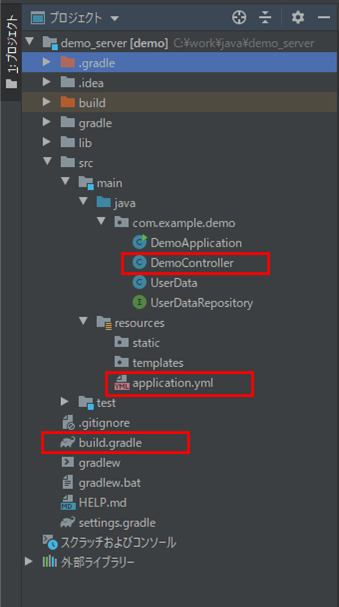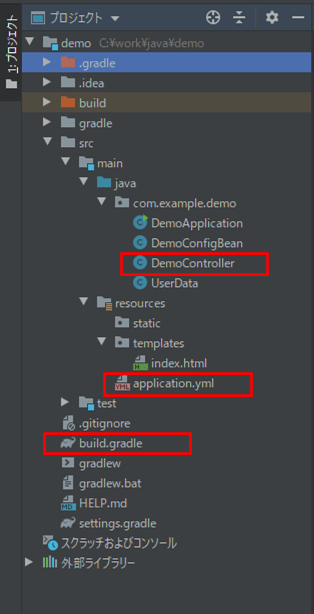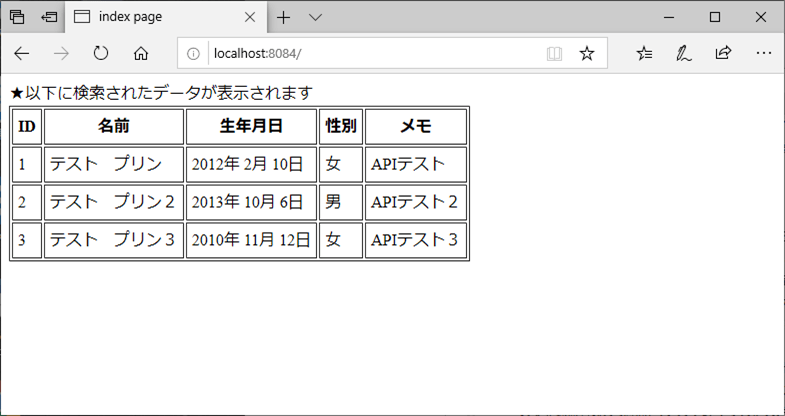今回は、以前作成したREST API通信のプログラムを、共通鍵暗号方式の1つであるAES(Advanced Encryption Standard)を利用して暗号化するようにしてみたので、そのサンプルプログラムを共有する。
共通鍵暗号方式については、以下のサイトを参照のこと。
https://www.infraexpert.com/study/security4.html
前提条件
下記記事のサンプルプログラムの作成と前提条件のデータ作成が完了していること。

サーバー側のプログラムの作成と実行
作成したサーバー側(demo_server)サンプルプログラムの構成は以下の通り。

なお、上記の赤枠は、前提条件のプログラムから変更したプログラムである。
build.gradleの内容は以下の通りで、暗号化を行うための設定を追加している。
plugins {
id 'org.springframework.boot' version '2.1.7.RELEASE'
id 'java'
}
apply plugin: 'io.spring.dependency-management'
group = 'com.example'
version = '0.0.1-SNAPSHOT'
sourceCompatibility = '1.8'
repositories {
mavenCentral()
}
dependencies {
implementation 'org.springframework.boot:spring-boot-starter-thymeleaf'
implementation 'org.springframework.boot:spring-boot-starter-web'
testImplementation 'org.springframework.boot:spring-boot-starter-test'
//lombokの設定を追加
compileOnly 'org.projectlombok:lombok:1.18.10'
annotationProcessor 'org.projectlombok:lombok:1.18.10'
//oracleを利用するための設定を追加
compile files('lib/ojdbc6.jar')
implementation 'org.springframework.boot:spring-boot-starter-data-jpa'
//暗号化を行うための設定を追加
compile group: 'commons-codec', name: 'commons-codec', version: '1.8'
}
application.ymlの内容は以下の通りで、暗号化に必要な項目を追加している。 暗号化キー(key)は、16バイトの文字列を設定している。
# ポート番号:8085で起動
server:
port: 8085
# DB接続情報
spring:
datasource:
url: jdbc:oracle:thin:@localhost:1521:xe
username: USER01
password: USER01
driverClassName: oracle.jdbc.driver.OracleDriver
# 暗号化項目を設定
encrypt:
algorithm: AES
charset: utf-8
key: 1234567890abcdef 
コントローラクラスの内容は以下の通りで、encryptメソッドでAESによる暗号化を行っている。なお、暗号化に必要な項目値は、application.ymlから取得している。
package com.example.demo;
import com.fasterxml.jackson.core.JsonProcessingException;
import com.fasterxml.jackson.databind.ObjectMapper;
import org.apache.commons.codec.binary.Base64;
import org.springframework.beans.factory.annotation.Autowired;
import org.springframework.beans.factory.annotation.Value;
import org.springframework.data.domain.Sort;
import org.springframework.util.StringUtils;
import org.springframework.web.bind.annotation.GetMapping;
import org.springframework.web.bind.annotation.RestController;
import javax.crypto.Cipher;
import javax.crypto.spec.SecretKeySpec;
import java.util.List;
import static org.springframework.data.domain.Sort.Direction.ASC;
@RestController
public class DemoController {
/**
* 暗号化アルゴリズム
*/
@Value("${encrypt.algorithm}")
private String encryptAlgorithm;
/**
* 暗号化時に利用する文字コード
*/
@Value("${encrypt.charset}")
private String encryptCharset;
/**
* 暗号化時に利用する秘密鍵
*/
@Value("${encrypt.key}")
private String encrypyKey;
/**
* ユーザーデータテーブル(user_data)へアクセスするリポジトリ
*/
@Autowired
private UserDataRepository repository;
/**
* ユーザーデータを全件取得する
* @return ユーザーデータリスト(JSON形式)
*/
@GetMapping("/getUserDataList")
public String getUserDataList(){
List<UserData> userDataList = repository.findAll(new Sort(ASC, "id"));
// ユーザーデータが取得できなかった場合は、null値を返す
if(userDataList == null || userDataList.size() == 0){
return null;
}
for(UserData userData : userDataList){
// 性別を表示用(男,女)に変換
userData.setSex("1".equals(userData.getSex()) ? "男" : "女");
// 名前・メモ・性別を暗号化
userData.setName(encrypt(userData.getName()));
userData.setMemo(encrypt(userData.getMemo()));
userData.setSex(encrypt(userData.getSex()));
}
// 取得したユーザーデータをJSON文字列に変換し返却
return getJsonData(userDataList);
}
/**
* 引数の文字列を暗号化する
* @param data 任意の文字列
* @return 暗号化後の文字列
*/
private String encrypt(String data) {
if(StringUtils.isEmpty(data)){
return "";
}
String retVal = null;
try {
// 暗号化キーオブジェクトを生成
SecretKeySpec key = new SecretKeySpec(
encrypyKey.getBytes(encryptCharset), encryptAlgorithm);
// Cipherオブジェクトを生成し、暗号化キーオブジェクトで初期化
// 暗号化キーは、鍵長を16バイト・24バイト・32バイトのいずれかに設定する必要がある
Cipher cipher = Cipher.getInstance(encryptAlgorithm);
cipher.init(Cipher.ENCRYPT_MODE, key);
// 引数の文字列を暗号化
byte[] byteResult = cipher.doFinal(data.getBytes(encryptCharset));
// Base64へエンコードし、暗号化文字列を返却
retVal = Base64.encodeBase64String(byteResult);
} catch (Exception e) {
e.printStackTrace();
}
return retVal;
}
/**
* 引数のオブジェクトをJSON文字列に変換する
* @param data オブジェクトのデータ
* @return 変換後JSON文字列
*/
private String getJsonData(Object data){
String retVal = null;
ObjectMapper objectMapper = new ObjectMapper();
try{
retVal = objectMapper.writeValueAsString(data);
} catch (JsonProcessingException e) {
System.err.println(e);
}
return retVal;
}
}その他のソースコード内容は、以下のサイトを参照のこと。
https://github.com/purin-it/java/tree/master/spring-boot-api-aes/demo_server
上記プログラムを作成し、Spring Bootアプリケーションを起動し、「http://localhost:8085/getUserDataList」にアクセスした結果は以下の通り。

名前(name)、性別(sex)、メモ(memo)を暗号化しているので、その内容が暗号化されていることが確認できる。
クライアント側のプログラムの作成と実行
作成したクライアント側(demo)サンプルプログラムの構成は以下の通り。

なお、上記の赤枠は、前提条件のプログラムから変更したプログラムである。
build.gradleの内容は以下の通りで、暗号化を行うための設定を追加している。
plugins {
id 'org.springframework.boot' version '2.1.7.RELEASE'
id 'java'
}
apply plugin: 'io.spring.dependency-management'
group = 'com.example'
version = '0.0.1-SNAPSHOT'
sourceCompatibility = '1.8'
repositories {
mavenCentral()
}
dependencies {
implementation 'org.springframework.boot:spring-boot-starter-thymeleaf'
implementation 'org.springframework.boot:spring-boot-starter-web'
testImplementation 'org.springframework.boot:spring-boot-starter-test'
//lombokの設定を追加
compileOnly 'org.projectlombok:lombok:1.18.10'
annotationProcessor 'org.projectlombok:lombok:1.18.10'
//暗号化を行うための設定を追加
compile group: 'commons-codec', name: 'commons-codec', version: '1.8'
}
application.ymlの内容は以下の通りで、暗号化に必要な項目を追加している。 暗号化キー(key)は、サーバー側と同じ文字列を設定している。
# ポート番号:8084で起動 server: port: 8084 # 暗号化項目を設定 encrypt: algorithm: AES charset: utf-8 key: 1234567890abcdef
コントローラクラスの内容は以下の通りで、decryptメソッドでAESで暗号化した内容を復号化している。
package com.example.demo;
import org.apache.commons.codec.binary.Base64;
import org.springframework.beans.factory.annotation.Autowired;
import org.springframework.beans.factory.annotation.Value;
import org.springframework.core.ParameterizedTypeReference;
import org.springframework.http.HttpMethod;
import org.springframework.http.ResponseEntity;
import org.springframework.stereotype.Controller;
import org.springframework.ui.Model;
import org.springframework.util.StringUtils;
import org.springframework.web.bind.annotation.GetMapping;
import org.springframework.web.client.RestTemplate;
import javax.crypto.Cipher;
import javax.crypto.spec.SecretKeySpec;
import java.util.List;
@Controller
public class DemoController {
/**
* 暗号化アルゴリズム
*/
@Value("${encrypt.algorithm}")
private String encryptAlgorithm;
/**
* 暗号化時に利用する文字コード
*/
@Value("${encrypt.charset}")
private String encryptCharset;
/**
* 暗号化時に利用する秘密鍵
*/
@Value("${encrypt.key}")
private String encrypyKey;
/**
* RestTemplateオブジェクト
*/
@Autowired
private RestTemplate restTemplate;
/**
* ユーザーデータを取得し、初期表示画面に遷移する
* @param model Modelオブジェクト
* @return 初期表示画面へのパス
*/
@GetMapping("/")
public String index(Model model){
// ユーザーデータリストをAPIで取得する
ResponseEntity<List<UserData>> response = restTemplate.exchange(
"http://localhost:8085/getUserDataList", HttpMethod.GET,
null, new ParameterizedTypeReference<List<UserData>>() {});
List<UserData> userDataList = response.getBody();
// 各ユーザーデータを編集し、Modelに設定する
for(UserData userData : userDataList){
// 名前・メモ・性別・生年月日を復号化
userData.setName(decrypt(userData.getName()));
userData.setMemo(decrypt(userData.getMemo()));
userData.setSex(decrypt(userData.getSex()));
}
model.addAttribute("userDataList", userDataList);
return "index";
}
/**
* 引数の文字列を復号化する
* @param data 任意の文字列
* @return 復号化後の文字列
*/
private String decrypt(String data){
if(StringUtils.isEmpty(data)){
return "";
}
String retVal = null;
try {
// 引数の文字列をBase64へデコード
byte[] byteText = Base64.decodeBase64(data);
// 暗号化キーオブジェクトを生成
SecretKeySpec key = new SecretKeySpec(
encrypyKey.getBytes(encryptCharset), encryptAlgorithm);
// Cipherオブジェクトを生成し、暗号化キーオブジェクトで初期化
// 暗号化キーは、鍵長を16バイト・24バイト・32バイトのいずれかに設定する必要がある
Cipher cipher = Cipher.getInstance(encryptAlgorithm);
cipher.init(Cipher.DECRYPT_MODE, key);
// 引数の文字列を復号化
byte[] byteResult = cipher.doFinal(byteText);
// 復号化後の文字列を返却
retVal = new String(byteResult, encryptCharset);
} catch (Exception e) {
e.printStackTrace();
}
return retVal;
}
}その他のソースコード内容は、以下のサイトを参照のこと。
https://github.com/purin-it/java/tree/master/spring-boot-api-aes/demo
サーバー・クライアント両方のSpring Bootアプリケーションを起動し、「http:// (ホスト名):8084」とアクセスすると、以下の画面が表示されることが確認できる。

要点まとめ
- Cipherクラスを利用すると、共通鍵暗号方式の1つであるAESを利用した処理を簡単に実装できる。
- AESで利用する暗号化キーは、鍵長を16バイト・24バイト・32バイトのいずれかに設定し、暗号化/復号化で同じ暗号化キーを利用する必要がある。





